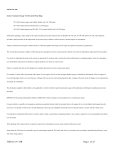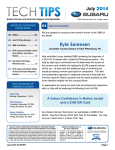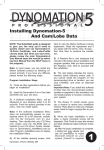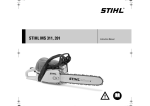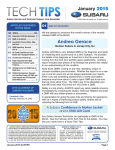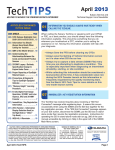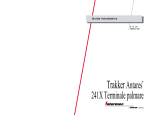Download TSB-02-143-13R - Wheel Drive Auto
Transcript
ATTENTION: GENERAL MANAGER PARTS MANAGER CLAIMS PERSONNEL SERVICE MANAGER q q q q IMPORTANT - All Service Personnel Should Read and Initial in the boxes provided, right. SERVICE BULLETIN APPLICABILITY:2013 Legacy & Outback Models with 2.5L FB Engines SUBJECT:Surface Treatment Change To Oil Control Piston Rings INTRODUCTION NUMBER:02-143-13R DATE: 09/19/13 REVISED: 03/20/14 This bulletin provides information regarding a change made to the surface treatment applied to the oil control piston rings for 2.5L FB engines. The change was made as a result of some limited findings of unanticipated wear of these rings. Oil consumption will be higher than normal and consistent, if this wear occurs, the condition remains until repair. Unusual swings or variations in oil consumption are not consistent with this condition and may be the result of vehicle usage rather than the condition described here. Additional information is supplied in this bulletin to assist in the assessment and determination if vehicle usage is a reason for this varied oil consumption. It is critical to understand the nature of the concern as reported by the customer and to confirm any actual condition prior to attempting any repairs. Some oil consumption can and should be expected as a by-product of engine operation where no concern exists. Failure to recognize this and correctly diagnose the condition presented can result in unnecessary repairs and in the worst case, an increase in oil consumption. The information supplied in this bulletin is only applicable to a limited number of vehicles within the specific production range noted below exhibiting the condition(s) previously described. It is important to read and understand this bulletin completely before starting an oil consumption test or initiating any repairs. Customer concerns related to possible oil consumption are generally initiated by one of two scenarios. • The customer reports the low engine oil level (not low engine oil pressure) lamp has illuminated. • The customer believes the engine oil level on the dipstick has dropped when checking the oil. Either of these situations by themselves does not directly indicate a concern with the vehicle exists beyond the need to add engine oil as part of normal maintenance. It is important to understand all the factors involved in order to make a sound decision regarding whether or not a repair is required or even if an oil consumption test should be started. When speaking with customers regarding a reported or suspected oil consumption concern, always keep the following information in mind: Continued... CAUTION: VEHICLE SERVICING PERFORMED BY UNTRAINED PERSONS COULD RESULT IN SERIOUS INJURY TO THOSE PERSONS OR TO OTHERS. Subaru Service Bulletins are intended for use by professional technicians ONLY. They are written to inform those technicians of conditions that may occur in some vehicles, or to provide information that could assist in the proper servicing of the vehicle. Properly trained technicians have the equipment, tools, safety instructions, and know-how to do the job correctly and safely. If a condition is described, DO NOT assume that this Service Bulletin applies to your vehicle, or that your vehicle will have that condition. Bulletin Number: 02-143-13R; Date: 03/20/14 SUBARU OF AMERICA, INC. IS “ISO 14001 COMPLIANT” The international standard for excellence in Environmental Management Systems. Please recycle or dispose of automotive products in a manner that is friendly to our environment and in accordance with all local, state and federal laws and regulations. Page 1 Some engine oil will always be consumed as part of normal engine operation. How much and when it is consumed varies according to manufacturing tolerances, wear, and vehicle usage. With the extended service intervals commonly used for today’s engines combined with one or more of the conditions listed below, typical engine oil consumption may require the adding of engine oil in between scheduled maintenance intervals. If a customer inquires about oil consumption and is close to their next service interval, and consumption has not exceeded 1 quart in that time, the consumption rate should not be considered unusual. Consumption at a rate greater than this should be reviewed on a case by case basis after reviewing the vehicle’s usage patterns / history. Higher than expected oil consumption may occur under any of the following conditions: • When the engine is new and within the break-in period (during the first 1000 miles of operation) • When the engine oil being used is of lower quality (other than “Energy or Resource Conserving” API Classification SM or SN or ILSAC, look for the starburst design with GF-4 or GF-5) • When the incorrect oil viscosity is used (viscosity other than 0W-20 in the case of these specific vehicles) • When engine braking is employed (Downshifting to make use of the transmission’s gear ranges and the engine to decelerate the vehicle) • When the engine is operated at high engine speeds (Continually or under frequent and repetitive hard acceleration such as frequent freeway merging) • When the engine is operated under heavy loads (Frequent carrying of cargo, multiple passengers or trailer towing) • When the engine idles for long periods of time (Frequent use of a remote engine start system followed by some period of idling as an example) • When the vehicle is operated in stop and go and/or heavy traffic situations • When the vehicle is used under severe temperature conditions (Cold or hot) • When the vehicle accelerates and decelerates frequently • Frequent short trip driving where the engine may not reach full operating temperature Under these or similar operating conditions, the oil level should be checked regularly. The engine oil and filter may also need to be changed more often. As related information, the engine oil low level warning light is designed to illuminate when the engine oil level in the sump is approximately 1.1 quarts low. This may vary with different driving and road conditions. Keep in mind that oil remains suspended in the engine while running and will not fully drain back until the engine has been shut off for at least 5 minutes. This is why waiting at least 5 minutes while parked on a level surface before checking the oil level is critical to getting an accurate gauge of the oil level in the engine. In some rare cases, this light may illuminate with more oil present when the engine is running due to specific road or driving conditions such as repeated hard acceleration / deceleration, tight turning, driving on undulating roads. In these cases, the engine oil low level warning light will generally reset on its own once the actual level is determined to be above the illumination threshold. This reset process may take some time as certain driving parameters must be met for the system to self-correct. As long as the oil level has been checked and adjusted (if necessary), the immediate concern has been addressed. If the engine oil low level warning light does not extinguish on its own after some time and the oil level remains full, an inspection of the oil level sensor circuit and components should be performed. NOTE: The engine’s specified oil capacity is 5.1 US quarts. Bulletin Number: 02-143-13R; Date: 03/20/14 Continued... Page 2 COUNTERMEASURE IN PRODUCTION The updated piston rings were incorporated into production at SIA on May 8, 2013, starting with VIN D3321342 (Outback) and D3048058 (Legacy). PART INFORMATION PART SIZE PART NUMBER 12033AC390 Piston Ring Set Std. 0.25 Oversize 0.50 Oversize 12033AC400 12033AC410 The chart below provides a required part list for the piston ring replacement procedure as outlined in this bulletin. It is provided as a reference only. Always verify with your Parts Department the most up-to-date part numbers are ordered. NOTE: Oversize piston rings are only used when cylinder boring and / or honing operations have been performed. Cylinder repair is not a part of the procedures outlined in this bulletin. The replacement short block part number is 10103AC410. PART NUMBER DESCRIPTION QTY. /REPAIR 44011AC030 Exhaust Gasket 2 44616AA200 Center Pipe Gasket 1 14035AA580 Intake Gasket 2 14852AA040 14738AA150 806912190 806924120 EGR Pipe Gasket O-Ring, Chain Cover 1 1 3 1 806916080 O-Ring, Tensioner 1 10966AA040 Seal, Spark Plug Tube 4 13270AA27A 13272AA21A Rocker Cover Gasket 1 1 806915170 O-Ring, Cam Carrier 4 11044AA790 Head Gasket 1 10944AA080 Head Gasket 1 12109AA120 Connecting Rod Bolt 8 806932030 O-Ring, Upper Oil Pan 3 21236AA050 Thermostat Gasket 1 806939060 O-Ring, Crank Extension 1 806750080 Oil Seal, Front Crankshaft 1 16608KA000 16698AA110 Injector O-Rings 4 4 15208AA15A Oil Filter 1 803916010 Gasket, Drain Plug 1 Continued... Bulletin Number: 02-143-13R; Date: 03/20/14 Page 3 MISCELLANEOUS MATERIALS (WARRANTY PART NUMBERS) PART DESCRIPTION QUANTITY SOA635065 SOA635041 SOA635045 ThreeBond 1280B / 1217G Super Coolant, (qt.) Engine Oil (qt.) 0W-20 1 8 6 SERVICE PROCEDURE / INFORMATION Before starting any repairs, the first step is to always confirm the customer’s complaint. It is critical to get as much information from the customer as possible to allow for the most accurate diagnosis. • Review all the available service and repair history along with any other records the customer can provide to establish whether or not the vehicle has been properly maintained. • Perform a thorough visual inspection to make sure there are no external oil leaks that could be contributing to the condition. • It is also very important to not overlook the engine’s PCV system and to confirm it is operating properly. Check the air filter assembly and throttle body / intake manifold for any excessive oil residue which could be an indicator of a sticking or failed PCV valve. NOTE: An oil consumption test will need to be completed to determine the proper course of action. There is a specific procedure and Oil Consumption Test form to be used with this bulletin ONLY. IMPORTANT: As of 11/5/2013, a revised Oil Consumption Test form and new submission procedures have been established. This revised form is located on Subarunet>Service>Forms > NEW FB Engine Oil Control Ring TSB Oil Consumption Test. It includes a group of 5 questions which must be answered at the time the car is presented with an oil consumption concern where a technician believes an oil consumption concern may exist. Once this questionnaire section of the form is completed, it must be faxed to 856-488-3199. Upon completion of the actual consumption test, the remainder of the form must be completed and faxed AGAIN to 856-488-3199. This information is being collected for quality assurance purposes only. You will not receive any response from these submissions. This is NOT an authorization process. Proceed with any necessary testing or repairs as indicated by the information provided in this service bulletin, the Oil Consumption Test form results, Subaru’s Claims Policies and Procedures, and your evaluation of the actual condition presented based upon your review of all three areas. Keep in mind, these repairs should only be completed when unusual oil consumption has been confirmed. The form can be located by accessing: Subarunet / Service / Forms / NEW FB Engine Oil Control Ring TSB Oil Consumption Test. The standard oil consumption test form and guidelines will still apply in all cases other than this bulletin. Once all the basics have been checked and the vehicle service history established, change the engine oil and filter to begin the oil consumption test. Always close the repair order on the day the oil change has been completed and submit the claim for the oil consumption test using the coding provided at the end of this bulletin. Indicate “Oil Consumption Test” in the comments field / box when entering your claim. DO NOT hold the repair order open until the vehicle returns. Have the customer drive the vehicle then return for inspection when any of the following have occurred: • At least 1200 miles have elapsed • The engine oil low level warning light illuminates • When the oil level reaches the lower hole in the dipstick/ gauge (as determined by the Continued... customer) Bulletin Number: 02-143-13R; Date: 03/20/14 Page 4 The customer should be advised to not add oil unless there will be a significant delay before they can return for inspection once a low oil level condition occurs. A one-time check of the oil consumption by the dealer is all that is needed to establish if the condition outlined in this bulletin applies. NOTES: • Once the engine is apart and the piston / connecting rod assemblies are removed, always confirm the cylinders are not scored excessively or damaged and the bore measurements are within the roundness and taper specifications supplied in the Service Manual. • Minor visible scoring is expected and acceptable. Any vertical scoring found on the cylinder walls should not be able to be caught with a finger nail. • There is no need to remove the pistons from the connecting rods. • Always make sure to install the new rings in the proper direction (marks facing upward on the top and 2nd ring) and end gaps in the proper locations as outlined in the Service Manual and later in this bulletin. • Confirm the new top and second rings turn freely in the piston ring lands following their installation and prior to cylinder insertion. • Cylinder honing is not required or recommended. SPECIFIC PROCEDURES The following information is provided to underscore procedures specific to the repairs outlined in this bulletin and are not meant to represent the entire repair process from start to finish. The procedures provided here are specific to only specific certain steps in the overall process. In some cases, they will differ greatly from the Service Manual instructions and should be followed in place of the Service Manual for these specific areas. For the balance of the repair procedure, refer to the Service Manual. It is highly recommended to review all of the related Service Manual procedures for piston ring replacement then review these specific procedures to become familiar with the differences. • When draining the engine oil, do not remove the engine oil filter. Leave the existing oil filter in place through engine disassembly, reassembly, installation and initial startup after engine reassembly. • When removing the engine, there is no need to remove the transmission case cover (CVT only) or to disconnect / disturb any of the transmission harness connectors. While raising the transmission with the service jack placed under the front differential as shown in the illustration below, only raise it enough to access and remove the engine mounting hardware. Raising it too high can push the transmission up into the bulkhead / transmission tunnel and possibly cause damage. Continued... Bulletin Number: 02-143-13R; Date: 03/20/14 Page 5 • When removing the CVT fluid cooler, leave it attached to the mounting bracket and remove it as an assembly (3 bolts) from the transmission. Disconnect just the engine coolant hoses from it and leave the 2 short CVT fluid lines alone. Hook one of the cooler’s mounting bracket “ears” behind the bulkhead harness as shown in the photo below to keep the cooler assembly out of your way. Use a shop cloth between the “ear” and the bulkhead harness to prevent any chafing. • To make separating the transmission (CVT) from the engine easier, there is a pry relief shown below in the machined mounting surface of the transmission case near the engine number. Use caution when applying any prying pressure and avoid twisting the tool to prevent case damage. Continued... Bulletin Number: 02-143-13R; Date: 03/20/14 Page 6 • Once the engine is removed, if you are using a generic engine stand (preferable since engine rotation is necessary), use the four mounting holes on the engine block shown below to mount it. Do not use the studs in the upper oil pan as the upper oil pan has to be removed to access the connecting rod bolts. NOTE: The connecting rod bolts are one-time-use and must be replaced. • When removing the intake manifold, as shown in the photos below, leave the TGV assemblies attached to the upper intake, remove the 2 nuts holding the EGR tube to the water pipe then remove the complete assembly from the cylinder heads as a unit. • There is no need to remove the oil dipstick tube or the original oil filter from the front chain cover. While the cover is removed, store it face (front side) down to minimize the chances of damaging the machined sealing surface on the block / head side. Also, don’t use it as a tray to store other removed parts. This will help to reduce the chances of contamination entering the various oil passages throughout the front cover. Continued... Bulletin Number: 02-143-13R; Date: 03/20/14 Page 7 • IMPORTANT: After all 32 bolts securing the chain cover are removed, be VERY careful where you pry and what you pry on to break the silicone sealant bond. The photos below show an example of where NOT to pry. In this case, the cam cap became cracked requiring a complete cam carrier replacement. Patience is the key! Reference View Rear View Chain Cover Prying on “Unsupported” Corner of Cam Cap • Refer to STIS for the instructions found in the Technician Reference Booklet (TRB) for Technical Training Module 105: “Chain Driven Valve Train Boxer Engines” when removing and reassembling the timing chain components. The photos and instructions found in the TRB and provided in this bulletin have shown to be preferable to those provided in the Service Manual. The following contains significant highlights from this material. • The timing chains driving the camshafts are identical and are provided with colored identification links used to align with component timing marks. Chain guides are also identical for the left and right banks. It is recommended to mark the parts as they are removed. Return them to their original positions during reassembly to maintain established wear patterns. Colors used for the identification links will vary. Continued... Bulletin Number: 02-143-13R; Date: 03/20/14 Page 8 • Begin timing chain removal by positioning the crankshaft keyway at the 6:00 position. The RIGHT bank intake camshaft timing mark (Δ) must be at 6:00 with right bank exhaust timing mark at 12:00 (camshafts will be unloaded). 6:00 6:00 12:00 • Compress the chain tensioner by hand, insert a pin through the lever into the access hole to lock the plunger in place then remove the 2 bolts, tensioner, guides and right side timing chain. • After turning the crankshaft CLOCKWISE, repeat the procedure for the LEFT side with the timing marks (Δ) positioned as shown below. Align the crankshaft sprocket keyway with RH chain dowel pin (shown in red below). 8:00 Dowel Pin 1:00 • Compress the chain tensioner by hand, insert a pin through the lever into the access hole to lock the plunger in place then remove the 2 bolts, tensioner, guides and the left side timing chain. • After the left chain is removed, turn the crankshaft in a COUNTER CLOCKWISE direction until the timing mark on the crankshaft sprocket (NOT the keyway) is back to the 6:00 position as shown below. This positions all the pistons away from TDC and prevents accidental contact between the pistons and valves. Continued... Bulletin Number: 02-143-13R; Date: 03/20/14 Page 9 Timing Mark Crankcase Seam • Before proceeding, rotate the engine 90 degrees so it is vertical, with one head facing up. • Remove the rocker cover then the cam carrier from the head that is “up”. Do not disturb the small camshaft end cap covers. Remove the cam carrier with the camshafts as an assembly. At this point, the rest of the valve train is sitting loose on the cylinder head. It is imperative all the rockers, selective lash caps and rocker pivots are returned to their original positions on the cylinder head during reassembly. TIP: An egg carton for each head makes a perfect organizer tray. Make sure to mark it as necessary (front, intake, exhaust) to eliminate any mixing of parts. Loosen the cylinder head bolts in proper order, remove the head, then flip the engine over and repeat the same steps for the opposite side. • A mild parts cleaner (avoid harsh chemicals with strong solvents) may be used with ScotchBrite™ Ultra-Fine #7448 (gray in color) to clean away any carbon ridge which may have formed at the top of the cylinder bores before removing the piston / rod assemblies. • Remove the cylinder heads then the piston / rod assemblies. Inspect the cylinder walls for any excessive or irregular wear patterns which could indicate an out-of-round condition. The short block will need to be replaced if the cylinder roundness or taper measurements are out of specification or if any vertical scoring is deep enough that it can be caught with a finger nail. • For the purpose of this repair, it is not necessary to remove the piston from the connecting rod. NOTE: if the piston pin circlips are removed for any reason, they must be replaced as they are one-time use. Again, it is not necessary to remove the pistons from the connecting rods to complete this repair. Continued... Bulletin Number: 02-143-13R; Date: 03/20/14 Page 10 • When cleaning the pistons prior to installing the new rings, take care not to damage the antifriction coating applied to the skirts. A mild parts cleaner may also be used with the ScotchBrite Ultra-Fine #7448 (gray in color) to loosen and remove carbon deposits from the piston crown and from between the ring lands. Do not use Scotch-Brite to clean the piston skirts as it can damage the anti-friction coating. The ends of a removed compression ring may be used to carefully clean deposits from inside the ring lands. Rinse the piston / rod assemblies thoroughly and dry before installing the new rings onto the pistons. Refer to the Service Manual and the illustrations below for ring direction (marks facing upward) and end gap placements before placing the piston/rod assembly into the ring compressor. REMINDER: Always lubricate the rings, ring compressor, piston skirts, cylinder walls, wrist pin areas, rod bearing surfaces and rod bolt heads and threads liberally with engine oil before reassembly. E D F FRONT OF ENGINE B A C G “A”- Top compression ring end gap location “B”- Second compression ring end gap location (180 degrees away from “A”) “C”- Top oil control scraper ring end gap “D”- Recess in top of ring land to accept the “tang” of the upper oil control scraper ring - “E” “F” - Expander gap (180 degrees away from “C”) “G” - Bottom oil control scraper ring end gap (120 degrees away from “C”) Continued... Bulletin Number: 02-143-13R; Date: 03/20/14 Page 11 • When reinstalling the piston / rod assemblies back into the block, take time to ensure the piston ring compressor being used is completely down flush all the way around onto the deck surface. If not “sealed” to the deck and firmly held in place, the oil control scraper rings may pop out of the compressor and become damaged during installation, especially if too much force is used. The oil control rings are not available separately from a complete ring set so, be sure to take your time and do not force anything. • ALWAYS install new connecting rod bolts as they are one-time use items. Recommended Ring Compressor; Special Tool J-50553 • It is very important to take the time necessary to thoroughly clean the old silicone sealer from all the removed components before reassembly. It is a good idea to clean the surrounding areas then use tape to block off any oil passages in the front cover and cam carrier so any small bits of removed silicone debris are kept from entering the oil passages and possibly causing problems after reassembly. Once all the old sealer has been removed, remove any block-off tape, rinse out any oil passages thoroughly with brake cleaner and shop air. • Don’t forget to clean (without removing) the filter screens in the cam carriers (one filter in each carrier). In addition, always be sure to do a thorough inspection and cleaning of the oil pan, pick-up tube and screen as shown in the photos below before reassembly. Cam Carrier Filter Screen Oil Pick Up Tube/Filter Screen Assembly Continued... Bulletin Number: 02-143-13R; Date: 03/20/14 Page 12 IMPORTANT REMINDER: To eliminate possible confusion, it is strongly recommended to follow the timing chain reinstallation procedure outlined in this TSB and / or the Technician Reference Booklet (TRB) for Module 105: “Chain Driven Valve Train Boxer Engines” instead of the Service Manual procedure. • To begin timing chain re-installation, turn the crankshaft COUNTER-CLOCKWISE until the crankshaft sprocket keyway is back to the 6:00 position. This positions the pistons away from TDC and prevents accidental contact with the valves. NOTE: The keyway is NOT a timing mark. Keyway Timing Mark • Arrange the timing marks as shown below, turning the crankshaft CLOCKWISE into position. Align the indicator link with the timing mark on the crankshaft sprocket, keyway with the dowel pin. Continued... Bulletin Number: 02-143-13R; Date: 03/20/14 Page 13 • Align the indicator links to the timing marks found on the outside of the sprocket assemblies as shown in the photos below (Exhaust sprocket face images will vary with / without exhaust VVT). Timing Marks Aligned With Indicator Links Intake and Exhaust VVT Sprocket No VVT Exhaust Sprocket • Install the chain guides and tensioner. Once proper positioning has been confirmed, pull the pin to release the tensioner. With your hand, grab and squeeze the upper and lower chain / guides together as shown in the reference photo below to allow the plunger in the tensioner to fully extend and “click” into its furthest notch. • If you have 3 notches showing, you want to get one more “click” so that 4 notches are visible as shown in the photos below. If you have 4 showing, you want to end up with 5. Whether you start with 3 or 4 will depend on the amount of wear present on the chains and guides. The number of clicks listed here is simply a guide. The point is to ensure proper initial chain tension is applied to avoid creating a brief rattle sound at engine start. Continued... Bulletin Number: 02-143-13R; Date: 03/20/14 Page 14 • If necessary, insert a plastic screwdriver handle between the lip of the block and the left side (B2) guide. Then, VERY CAREFULLY push down on the guide just enough to get the extra tensioner notch / “click”. When using this method, always make sure you are using plastic on plastic and NOT metal on plastic to avoid damaging the chain guides. Plastic screw driver handle inserted between front lip of the block and the B2 upper chain guide VERY CAREFULLY pushing downward on the upper guide. • Rotate the crankshaft COUNTER-CLOCKWISE until the crankshaft sprocket timing mark is at the 6:00 position. Position the cam sprocket timing marks as shown below; intake 6:00, exhaust 12:00. 6:00 12:00 • Align the indicator link with the timing mark on the crankshaft sprocket as shown below. Continued... Bulletin Number: 02-143-13R; Date: 03/20/14 Page 15 • Same as the left side, align the indicator links to the timing marks found on the cam sprocket assemblies. Install the chain guides and tensioner. Once proper positioning has been confirmed, pull the pin to release the tensioner. With your hand, grab and squeeze the upper and lower left side chain / guides together to allow the plunger in the tensioner to fully extend and click into its furthest notch as shown in the previous (right side) photo. If necessary, insert a rubber-coated plier handle between the ledge area on the front of the block and the right side (B1) lower chain guide. Then, VERY CAREFULLY lift up on the guide just enough to get the extra “click” on the tensioner as shown in the photo below. Rubber-coated plier handle inserted between a ledge area on the front of the block and the B1 lower chain guide VERY CAREFULLY lifting upward on the lower guide. • IMPORTANT: When re-installing the front cover assembly, be very careful to not allow it to contact any of the timing sprockets. If contact does occur, it will most likely be with the exhaust sprockets and it is almost a guarantee the silicone sealer you have carefully put on the front cover will be disturbed. If not properly addressed, that area will most likely be the source of an oil leak. Don’t hesitate to use a helper for the front cover installation to prevent this. • Once the engine is back in the car and filled with fluids, remove the fuel pump fuse and crank the engine over to prime the oiling system (for no more than 10 seconds at a time) until the oil pressure warning light goes out. Re-install the fuel pump fuse then run the engine initially with the original oil filter remaining installed on the front cover for approximately 5 minutes to catch any other remaining debris. Check for any leaks then install a new oil filter. Start the engine again and run it for another few minutes. Shut off the engine and let it cool down for at least five minutes. Re-check and top off the engine oil to the full mark (upper hole) on the dipstick before releasing the vehicle. • It should be noted that some higher than expected oil consumption may occur initially following these repairs for approximately the first 500 miles (or 1000 miles if the shortblock has been replaced) until the new piston rings become seated with the cylinder walls. While higher, this consumption should not be severe. This will improve over time with driving until the expected consumption rate is achieved. Continued... Bulletin Number: 02-143-13R; Date: 03/20/14 Page 16 WARRANTY / CLAIM INFORMATION For vehicles within the Basic New Car Limited and/or Powertrain Warranty, this repair may be claimed using the following information: LABOR DESCRIPTION LABOR OPERATION # FAIL CODE LABOR TIME 6MT CVT Oil Consumption Test including Oil & Filter Change, Oil Leak & PCV System Inspection A295-308 AFU-86 0.5 Engine R&R & Piston Ring Replacement A295-346 AFT-48 Bulletin Number: 02-143-13R; Date: 03/20/14 12.6 13.1 Page 17

















